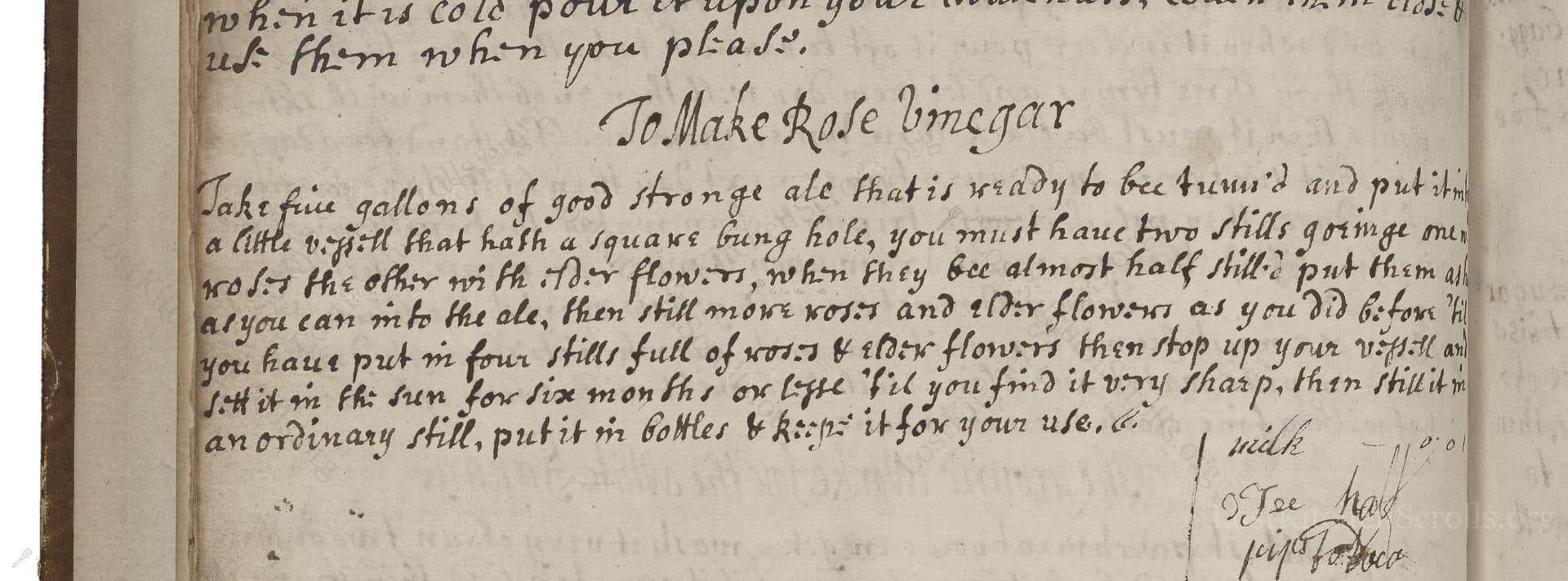To Make Rose Vinegar
From the treasured pages of Receipts in cookery and medicine 1700
Unknown Author

To Make Rose Vinegar
"Take five gallons of good strong ale that is ready to bee turn'd and put it into a little vessill that hath a square bung hole, you must have two stills goeinge one after the other with elder flowers, when they bee almost half still'd put them ashore now roses and elder flowers as you did before till as you can into the ale, then still more of roses & elder flowers then stop up your vessill and let it lye in the sun for six moneths or lesse 'til you find it very sharp, then still it in an ordinary still, put it in bottles & keepe it for your use. &c."
Note on the Original Text
The recipe is written in period English, with spelling and punctuation reflecting habits of the early 18th century. Directions are continuous and informal, assuming the reader’s familiarity with brewing and distillation. Phrasing like 'bee turn'd' refers to ale beginning to sour or ferment into vinegar. Instructions to 'still' refer to both distilling and infusing flavor through heat, a common ambiguity of older culinary texts. Recipe structure relies on narrative flow, not stepwise instructions, and precise amounts are given as rough measures instead of weights or volumes.

Title
Receipts in cookery and medicine 1700 (1700)
You can also click the book image above to peruse the original tome
Writer
Unknown
Era
1700
Publisher
Unknown
Background
Step into the kitchen of the early 18th century, where this charming culinary manuscript tempts tastebuds with recipes and secrets from a bygone era. A delicious journey for both the curious cook and the history lover.
Kindly made available by
Folger Shakespeare Library
This recipe appears in 'V.b.273', a manuscript dating to approximately 1700, a time when vinegar was both a culinary staple and an important household preservative. Vinegars infused with flowers like roses and elderflowers were fashionable in the kitchens of the English gentry, appreciated both for their flavor and their perceived health benefits. Rose vinegar in particular connected everyday culinary practice with the luxurious and symbolic use of roses in early modern England.

The original method would have called for a small wooden cask with a square bung hole, copper or pewter ale stills for infusing the flowers, and a rudimentary pot still for distilling the finished vinegar. Sunlight played a vital role in the process, helping to ferment and mature the ale into sharp vinegar. For bottling, glass bottles sealed with cork or wax were used. Today, you might use a glass or food-safe plastic fermenter, modern home-distillation equipment for the infusions and final distillation, and basic kitchen strainers and funnels for bottling.
Prep Time
30 mins
Cook Time
1 hr
Servings
190
We've done our best to adapt this historical recipe for modern kitchens, but some details may still need refinement. We warmly welcome feedback from fellow cooks and culinary historians — your insights support the entire community!
Ingredients
- 5 gallons strong ale (unpasteurized, ideally wild-fermenting)
- 14 oz dried elderflowers or 28 oz fresh elderflowers (can substitute elderflower cordial, 6.8 fl oz, for fragrance)
- 14 oz fresh rose petals (unsprayed, edible roses) or 7 oz dried
- Optional: 17 fl oz rosewater (if petals are unavailable)
Instructions
- To recreate this historical Rose Vinegar using modern ingredients and measurements, begin with 5 gallons of strong, unpasteurized ale (preferably one beginning to turn sour).
- Pour the ale into a large container with a wide opening (such as a food-grade fermenting vessel).
- Prepare infusions by distilling or steeping dried elderflowers and fresh or dried rose petals in batches—aim for at least 14 ounces of each, split over multiple infusions.
- Add these fragrant infusions to the ale, repeating the process several times to maximize aroma.
- Seal the vessel and let it sit in a warm, sunlit place for up to six months, or until the liquid is strongly acidic (tasting sharply vinegary).
- Once ready, distill the vinegar in a basic pot still, capturing the flavorful essence, then bottle and store it tightly sealed for use.
Estimated Calories
25 per serving
Cooking Estimates
You will need about 30 minutes to prepare the ingredients and start the infusions. The ale needs to sit and ferment for up to six months until it becomes vinegar. Cooking time is mostly for distilling at the end, which takes about 1 hour. Each serving is estimated based on 100 ml per portion.
As noted above, we have made our best effort to translate and adapt this historical recipe for modern kitchens, taking into account ingredients nowadays, cooking techniques, measurements, and so on. However, historical recipes often contain assumptions that require interpretation.
We'd love for anyone to help improve these adaptations. Community contributions are highly welcome. If you have suggestions, corrections, or cooking tips based on your experience with this recipe, please share them below.
Join the Discussion
Rate This Recipe
Dietary Preference
Main Ingredients
Culinary Technique
Occasions

Den Bockfisch In Einer Fleisch Suppen Zu Kochen
This recipe hails from a German manuscript cookbook compiled in 1696, a time whe...

Die Grieß Nudlen Zumachen
This recipe comes from a rather mysterious manuscript cookbook, penned anonymous...

Ein Boudain
This recipe comes from an anonymous German-language manuscript cookbook from 169...

Ein Gesaltzen Citroni
This recipe, dating from 1696, comes from an extensive anonymous German cookbook...
Browse our complete collection of time-honored recipes



